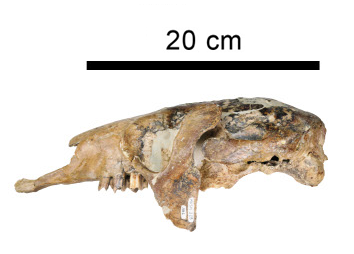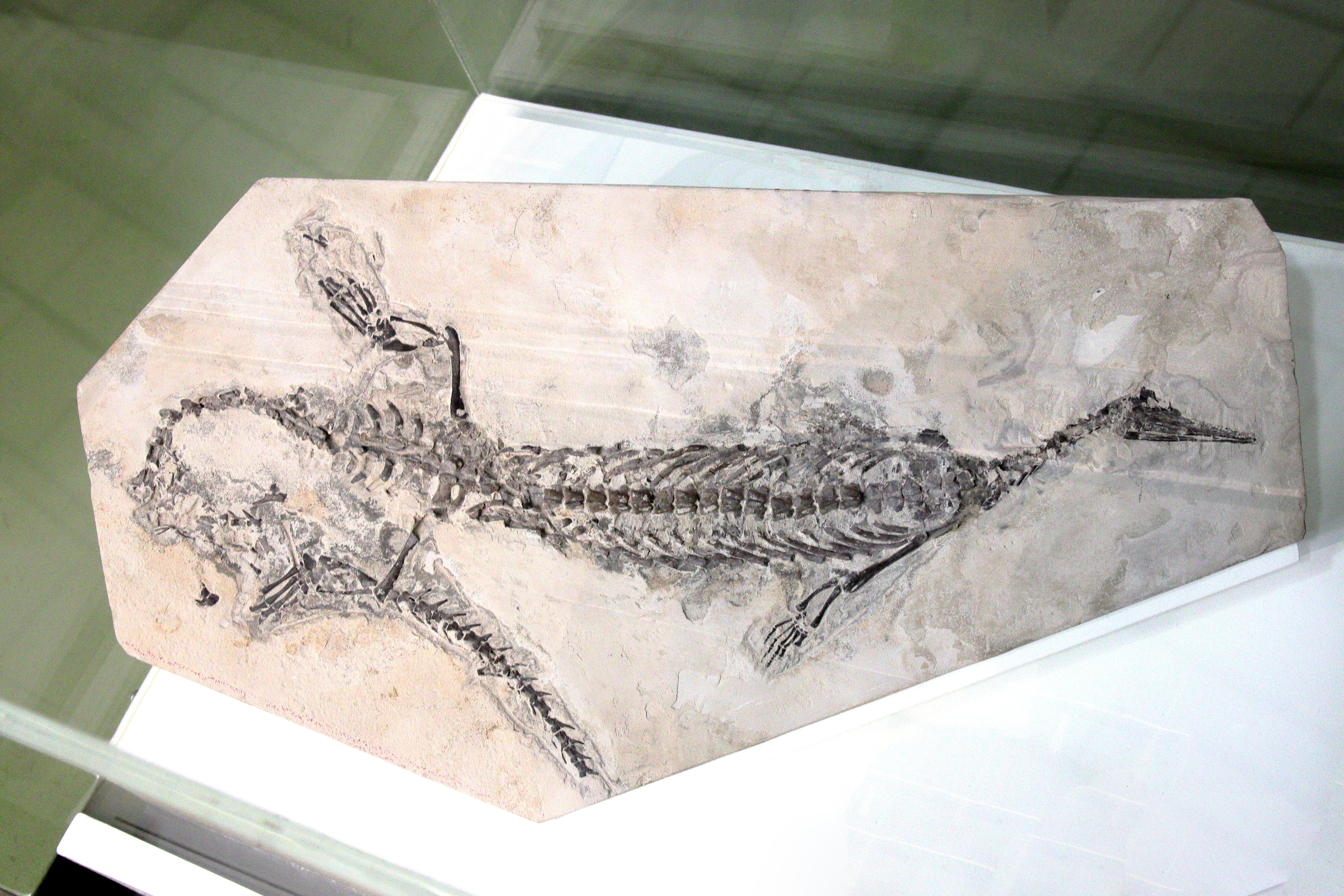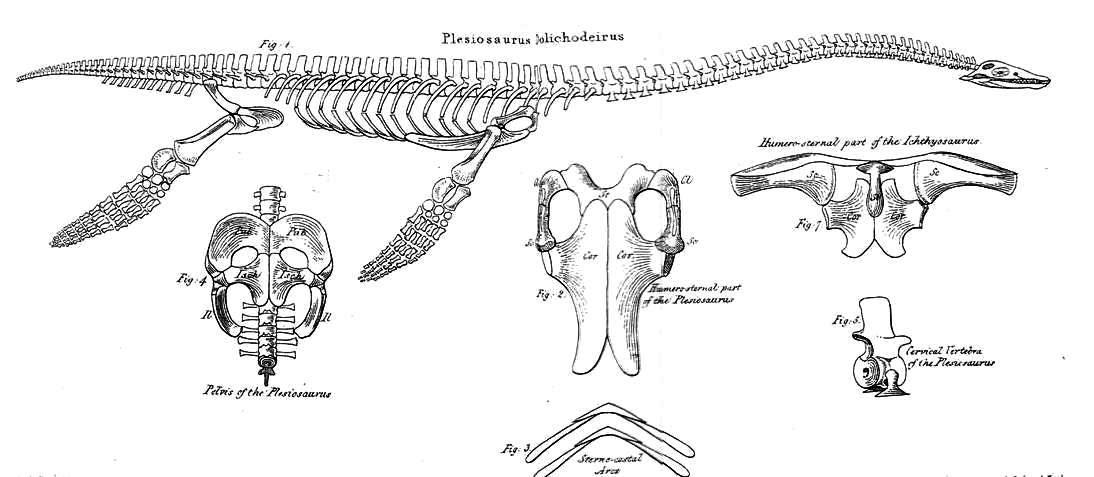|
Pachyosteosclerosis
Pachyosteosclerosis is a combination of thickening ( pachyostosis) and densification ( osteosclerosis) of bones. It makes bones more heavy, but also more fragile. The condition often occurs in aquatic vertebrates, especially those living in shallow waters,Houssaye, A. (2009). "Pachyostosis" in aquatic amniotes: a review. Integrative Zoology 4(4): 325-340. creating ballast as an adaptation for maintaining neutral buoyancy and horizontal trim. It is in no way pathological. To resist bend, it frequently is found especially in ventral bones, whereas concentration near the lungs helps in maintaining trim. Examples of animals showing pachyosteosclerosis are seacows ( dugongs and manatees), the extinct Plesiosauria and Mesosauria Mesosaurs ("middle lizards") were a group of small aquatic reptiles that lived during the early Permian period (Cisuralian), roughly Geologic time scale, 299 to 270 million years ago. Mesosaurs were the first known aquatic reptiles, having appar ... and exti ... [...More Info...] [...Related Items...] OR: [Wikipedia] [Google] [Baidu] |
Pachyostosis
Pachyostosis is a non-pathological condition in vertebrate animals in which the bones experience a thickening, generally caused by extra layers of lamellar bone. It often occurs together with bone densification ( osteosclerosis), reducing inner cavities. This joint occurrence is called pachyosteosclerosis. However, especially in the older literature, "pachyostosis" is often used loosely, referring to all osseous specializations characterized by an increase in bone compactness and/or volume. It occurs in both terrestrial and, especially, aquatic or semi-aquatic vertebrates. In aquatic animals, such as seacows (manatees and dugongs), ''Thalassocnus'', and plesiosaurs, pachyostosis in the thoracic region provides (or provided) ballast against the air-filled lungs. This maintains neutral buoyancy in aquatic habitats. Most giant deer showed pronounced pachyostosis of the mandible and skull. It has been suggested that this served to store minerals for antler growth. Many Pachycephal ... [...More Info...] [...Related Items...] OR: [Wikipedia] [Google] [Baidu] |
Osteosclerosis
Osteosclerosis is a disorder characterized by abnormal hardening of bone and an elevation in bone density. It may predominantly affect the medullary portion and/or cortex of bone. Plain radiographs are a valuable tool for detecting and classifying osteosclerotic disorders. It can manifest in localized or generalized osteosclerosis. Localized osteosclerosis can be caused by Legg–Calvé–Perthes disease, sickle-cell disease and osteoarthritis among others. Osteosclerosis can be classified in accordance with the causative factor into acquired and hereditary. Types Acquired osteosclerosis * Osteogenic bone metastasis caused by carcinoma of prostate and breast * Paget's disease of bone * Myelofibrosis (primary disorder or secondary to intoxication or malignancy) * Osteosclerosing types of chronic osteomyelitis * Hypervitaminosis D * Hyperparathyroidism * Schnitzler syndrome * Mastocytosis * Skeletal fluorosis * Monoclonal IgM Kappa cryoglobulinemia * Hepatitis C. Here ... [...More Info...] [...Related Items...] OR: [Wikipedia] [Google] [Baidu] |
Pachyostosis
Pachyostosis is a non-pathological condition in vertebrate animals in which the bones experience a thickening, generally caused by extra layers of lamellar bone. It often occurs together with bone densification ( osteosclerosis), reducing inner cavities. This joint occurrence is called pachyosteosclerosis. However, especially in the older literature, "pachyostosis" is often used loosely, referring to all osseous specializations characterized by an increase in bone compactness and/or volume. It occurs in both terrestrial and, especially, aquatic or semi-aquatic vertebrates. In aquatic animals, such as seacows (manatees and dugongs), ''Thalassocnus'', and plesiosaurs, pachyostosis in the thoracic region provides (or provided) ballast against the air-filled lungs. This maintains neutral buoyancy in aquatic habitats. Most giant deer showed pronounced pachyostosis of the mandible and skull. It has been suggested that this served to store minerals for antler growth. Many Pachycephal ... [...More Info...] [...Related Items...] OR: [Wikipedia] [Google] [Baidu] |
Thalassocnus
''Thalassocnus'' is an extinct genus of semiaquatic ground sloths from the Miocene and Pliocene of the Pacific South American coast. It is monotypic within the subfamily Thalassocninae. The five species—''T. antiquus'', ''T. natans'', ''T. littoralis'', ''T. carolomartini'', and ''T. yuacensis''—represent a chronospecies, a population gradually adapting to marine life in one direct lineage. They are the only known aquatic sloths, but they may have also been adapted to a terrestrial lifestyle. They have been found in the Pisco Formation of Peru, the Tafna Formation of Argentina, and the Bahía Inglesa Formation, Bahía Inglesa, Coquimbo Formation, Coquimbo, and Horcón Formation, Horcón formation (geology), formations of Chile. Thalassocninae has been placed in both the family (biology), families Megatheriidae and Nothrotheriidae. ''Thalassocnus'' evolved several marine adaptations over 4 million years, such as dense and heavy bones to counteract buoyancy, the internal nostri ... [...More Info...] [...Related Items...] OR: [Wikipedia] [Google] [Baidu] |
Prehistoric Marine Reptiles
Prehistory, also called pre-literary history, is the period of human history between the first known use of stone tools by hominins million years ago and the beginning of recorded history with the invention of writing systems. The use of symbols, marks, and images appears very early among humans, but the earliest known writing systems appeared years ago. It took thousands of years for writing systems to be widely adopted, with writing having spread to almost all cultures by the 19th century. The end of prehistory therefore came at different times in different places, and the term is less often used in discussing societies where prehistory ended relatively recently. It is based on an old conception of history that without written records there could be no history. The most common conception today is that history is based on evidence, however the concept of prehistory hasn't been completely discarded. In the early Bronze Age, Sumer in Mesopotamia, the Indus Valley Civilis ... [...More Info...] [...Related Items...] OR: [Wikipedia] [Google] [Baidu] |
Plesiosaurs
The Plesiosauria or plesiosaurs are an Order (biology), order or clade of extinct Mesozoic marine reptiles, belonging to the Sauropterygia. Plesiosaurs first appeared in the latest Triassic Period (geology), Period, possibly in the Rhaetian stage, about 203 million years ago. They became especially common during the Jurassic Period, thriving until their disappearance due to the Cretaceous–Paleogene extinction event at the end of the Cretaceous Period, about 66 million years ago. They had a worldwide oceanic distribution, and some species at least partly inhabited freshwater environments. Plesiosaurs were among the first fossil reptiles discovered. In the beginning of the nineteenth century, scientists realised how distinctive their build was and they were named as a separate order in 1835. The first plesiosaurian genus, the eponymous ''Plesiosaurus'', was named in 1821. Since then, more than a hundred valid species have been described. In the early twenty-first cent ... [...More Info...] [...Related Items...] OR: [Wikipedia] [Google] [Baidu] |
Prehistoric Mammals Of South America
Prehistory, also called pre-literary history, is the period of human history between the first known use of stone tools by hominins million years ago and the beginning of recorded history with the invention of writing systems. The use of symbols, marks, and images appears very early among humans, but the earliest known writing systems appeared years ago. It took thousands of years for writing systems to be widely adopted, with writing having spread to almost all cultures by the 19th century. The end of prehistory therefore came at different times in different places, and the term is less often used in discussing societies where prehistory ended relatively recently. It is based on an old conception of history that without written records there could be no history. The most common conception today is that history is based on evidence, however the concept of prehistory hasn't been completely discarded. In the early Bronze Age, Sumer in Mesopotamia, the Indus Valley Civilis ... [...More Info...] [...Related Items...] OR: [Wikipedia] [Google] [Baidu] |
Skeletal System
A skeleton is the structural frame that supports the body of most animals. There are several types of skeletons, including the exoskeleton, which is a rigid outer shell that holds up an organism's shape; the endoskeleton, a rigid internal frame to which the organs and soft tissues attach; and the hydroskeleton, a flexible internal structure supported by the hydrostatic pressure of body fluids. Vertebrates are animals with an endoskeleton centered around an axial vertebral column, and their skeletons are typically composed of bones and cartilages. Invertebrates are other animals that lack a vertebral column, and their skeletons vary, including hard-shelled exoskeleton (arthropods and most molluscs), plated internal shells (e.g. cuttlebones in some cephalopods) or rods (e.g. ossicles in echinoderms), hydrostatically supported body cavities (most), and spicules (sponges). Cartilage is a rigid connective tissue that is found in the skeletal systems of vertebrates and invert ... [...More Info...] [...Related Items...] OR: [Wikipedia] [Google] [Baidu] |
Animal Anatomy
Anatomy () is the branch of Morphology (biology), morphology concerned with the study of the internal structure of organisms and their parts. Anatomy is a branch of natural science that deals with the structural organization of living things. It is an old science, having its beginnings in prehistoric times. Anatomy is inherently tied to developmental biology, embryology, comparative anatomy, evolutionary biology, and phylogeny, as these are the processes by which anatomy is generated, both over immediate and long-term timescales. Anatomy and physiology, which study the structure and function (biology), function of organisms and their parts respectively, make a natural pair of related disciplines, and are often studied together. Human anatomy is one of the essential basic sciences that are applied in medicine, and is often studied alongside physiology. Anatomy is a complex and dynamic field that is constantly evolving as discoveries are made. In recent years, there has been a ... [...More Info...] [...Related Items...] OR: [Wikipedia] [Google] [Baidu] |
Mesosauria
Mesosaurs ("middle lizards") were a group of small aquatic reptiles that lived during the early Permian period (Cisuralian), roughly Geologic time scale, 299 to 270 million years ago. Mesosaurs were the first known aquatic reptiles, having apparently returned to an aquatic lifestyle from more terrestrial ancestors. It is uncertain which and how many terrestrial traits these ancestors displayed; recent research cannot establish with confidence if the first amniotes were fully terrestrial, or only amphibious. Most authors consider mesosaurs to have been aquatic, although adult animals may have been amphibious, rather than completely aquatic, as indicated by their moderate skeletal adaptations to a semiaquatic lifestyle.Pablo Nuñez Demarco et al. Was Mesosaurus a Fully Aquatic Reptile? Front. Ecol. Evol, published online July 27, 2018; doi: 10.3389/fevo.2018.00109 Similarly, their affinities are uncertain; they may have been among the most basal sauropsids or among the most basal p ... [...More Info...] [...Related Items...] OR: [Wikipedia] [Google] [Baidu] |
Plesiosauria
The Plesiosauria or plesiosaurs are an order or clade of extinct Mesozoic marine reptiles, belonging to the Sauropterygia. Plesiosaurs first appeared in the latest Triassic Period, possibly in the Rhaetian stage, about 203 million years ago. They became especially common during the Jurassic Period, thriving until their disappearance due to the Cretaceous–Paleogene extinction event at the end of the Cretaceous Period, about 66 million years ago. They had a worldwide oceanic distribution, and some species at least partly inhabited freshwater environments. Plesiosaurs were among the first fossil reptiles discovered. In the beginning of the nineteenth century, scientists realised how distinctive their build was and they were named as a separate order in 1835. The first plesiosaurian genus, the eponymous '' Plesiosaurus'', was named in 1821. Since then, more than a hundred valid species have been described. In the early twenty-first century, the number of discoveries ... [...More Info...] [...Related Items...] OR: [Wikipedia] [Google] [Baidu] |







